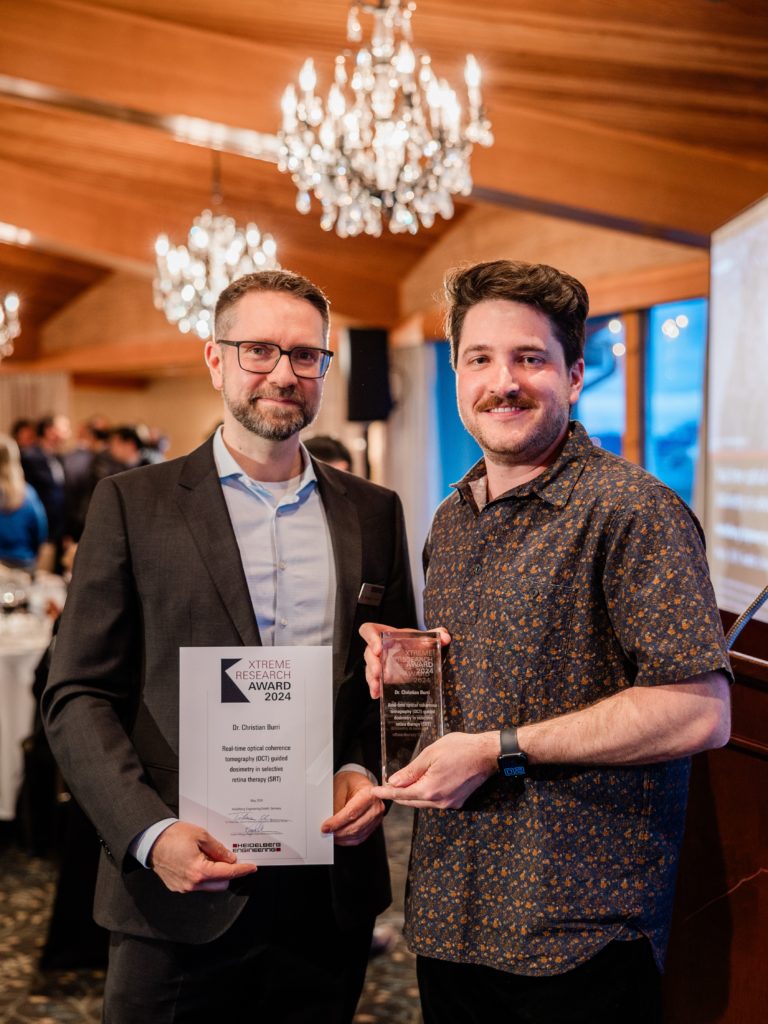HEIDELBERG ENGINEERING XTREME RESEARCH AWARD WINNER ANNOUNCED

HEIDELBERG, Germany, May 21, 2024 – Highlighting the work of “outstanding researchers” in ophthalmic imaging, the 14th annual Heidelberg Engineering Xtreme Research Award has been presented to Dr Christian Burri, PhD Biomedical Engineering, optoLab Institute for Human Centered Engineering, Bern University of Applied Sciences, and Institute of Applied Physics at the University of Bern.
Dr Burri – selected from an impressive shortlist – received his award at an evening ceremony during ARVO, the annual meeting of the Association for Research in Vision and Ophthalmology which was held in Seattle. His research, Real time optical coherence tomography guided dosimetry in selective retina therapy, is being facilitated by the high-resolution images and multi-modal functionality of the Heidelberg Engineering SPECTRALIS.
Dr Burri was honoured to be selected –
“This award marks the great successes in the research arena. I can honestly say that I was more thrilled to receive this than finishing my PhD.”
Sebastian Rausch, Clinical Development Manager for Investigational Technologies at Heidelberg Engineering, praised the work of Dr Burri, along with the previous winners of the coveted research award –
“Research in the field has the highest value as it reaches the greatest number of patients. This year’s winner is geared towards therapy, while many of the previous winners have focused on diagnosis and management of therapies.”
The prestigious title, which comes with a €2,500 award, emphasizes the importance of collaboration. Dr Burri’s study brings together Heidelberg Engineering with Meridian Medical AG Switzerland, a producer of treatment lasers.
Sebastian Rausch explained –
“We have been exploring the potential of treating Retinal Pigment Epithelium (RPE) pathologies, and potentially other conditions, with selective retinal therapy, removing diseased cells without damaging neighbouring tissue, most importantly the photoreceptors.”
“Not many people are working in this field and, other devices historically, have not been able to achieve all that is potentially possible. We are using OCT to ensure the dosage and duration is highly controlled. This is the first time a specific, personalised treatment can be provided for these patients. As the neurosensory retina is not damaged, it should be possible to perform treatments close to, or even within, the fovea.”
This form of selective retinal therapy (SRT) has, until now, faced the challenge that laser transmission through the eye, and the pigmentation of the retina, varies greatly from person to person. Each individual laser spot requires a different pulse energy, and this has been a challenge for many researchers.
Dr Burri explained –
“For more than 20 years we have known that this treatment works but what was missing was a reliable, non-invasive control mechanism, which we believe we now have. It has been very good working with Heidelberg Engineering to develop the SPECTRALIS CENTAURUS prototype. Our work together commenced in 2017, and we believe this new research device integrates the treatment laser as an extension of the imaging platform.”
Approved by Swissmedic for clinical trials, the prototype has been used recently for a first-in-man safety study in a cohort of diabetic retinopathy patients, as part of a four-year study. They commenced in 2021 at Inselspital, Bern University Hospital.
Another cohort of AMD patients is due to start soon at the same hospital. Promising preliminary clinical trial data was presented at last year’s ARVO in Denver and will be presented in more detail within the next year, hopefully providing the clinical evidence needed to transition the technology from scientific research into clinical practice in the future.
About Heidelberg Engineering
Heidelberg Engineering continuously optimizes imaging and data technologies to provide ophthalmic solutions that empower clinicians to improve patient care. From its inception in 1990, the company has collaborated with scientists, clinicians, and industry to develop innovative products that deliver clinically relevant benefits.
Heidelberg Engineering’s growing product portfolio combines these core technologies: confocal microscopy, scanning lasers and optics, optical coherence tomography (OCT), real-time image processing and analytics, multimodal image management solutions (PACS), electronic medical records (EMR), and large-scale data analysis.
Company Contact:
Krysten Williams
krysten.williams@heidelbergengineering.com


